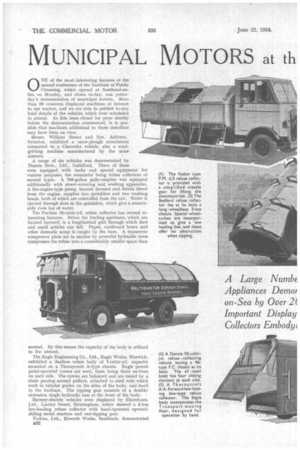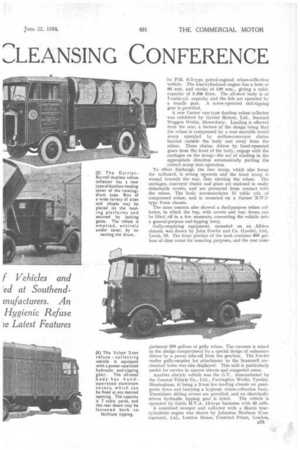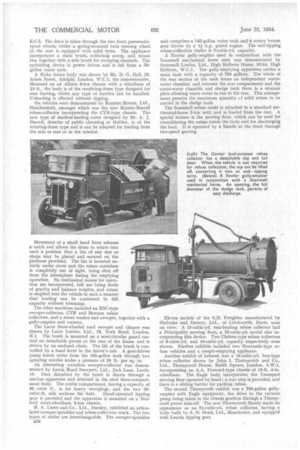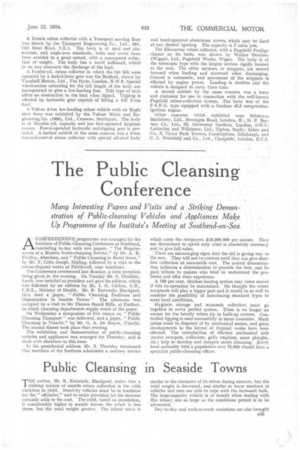MUN ICIPAL MOTORS at th
Page 46

Page 47

Page 48

Page 49

If you've noticed an error in this article please click here to report it so we can fix it.
CLEANSING CONFERENCE
A Large Numb Appliances Demor on-Sea by Over 2( Important Display Collectors Embodyi
f Vehicles and 'ed at SouthendInufaciurers. An Hygienic Refuse 'le Latest Features
0 NE of the most interesting features of the annual conference of the Institute of Public Cleansing, which opened at Southend-onSea on Monday, and closes to-day, was yesterday's demonstration of municipal motors. More than 20 concerns displayed machines of interest to our readers, and we are able to publish to-day brief details of the vehicles which were scheduled to attend. As this issue closed for press shortly before the demonstration commenced, it is possible that machines additional to those described may have been on view.
Messrs. William Bunco and Son, Ashbury, Swindon, exhibited a snow-plough attachment connected to a Chevrolet vehicle, also a roadgritting machine manufactured by the same concern.
A range of six vehicles was demonstrated by Dennis Bros., Ltd., Guildford. Three of these were equipped with tanks and special equipment for various purposes, the remainder being refuse collectors of several types. A 750-gallon gully-emptier was equipped additionally with street-watering and, washing apparatus. A fire-engine-type pump, located forward and driven direct from the engine, supplies two sprinklers and two washing heads, both of which are controlled from the cab. Water is ejected through slots in the sprinklers, which give a remarkably even fan of water.
The Pactum 10-cubic-yd. refuse collector has several interesting features. Below the loading apertures, which are located forward, is a longitudinal grid through which dust and small articles can fall. Paper, cardboard boxes and other domestic scrap is caught by the bars. A transverse compressor plate set in motion by powerful hydraulic rams compresses the 'refuse into a considerably smaller space than normal. By this means the capacity of the body is utilized to the utmost.
The Eagle Engineering Co., Ltd., Eagle Works, Warwick, exhibited a dustless refuse body of 7-cubic-yd. capacity mounted on a Thornycroft A-type chassis. Eagle patent pedal-operated covers are used, there being three sections on each side. The covers are balanced and are raised by a chain passing around pulleys, attached to steel rods which work in tubular guides on the sides of the body, and fixed to the footbars. The tipping gear consists of a doubleextension single hydraulic ram at the front of the body.
Battery-electric vehicles were displayed by Electricars, Ltd., Lawley Street, Birmingham, which showed a 2-ton low-loading refuse collector with hand-operated upwardsliding metal shutters and end-tipping gear.
Fodens, Ltd., Ehvorth Works, Sandbach, demonstrated Et32 its P.M. 4/3-type petrol-engined refuse-collection vehicle. The four-cylindered engine has a bore of 90 ram. and stroke of 130 mm., giving a cubic capacity of 3.308 litres. The all-steel body is of 7-cubic-yd. capacity and the lids are operated by a treadle gear. A screw-operated end-tipping gear is provided.
A new Garner van-type dustless refuse collector was exhibited by Garner Motors, Ltd., Sentinel Waggon Works, Shrewsbury. Loading is effected from the rear, a feature of the design being that the refuse is compressed by a rear movable metal scoop operated by endless-conveyor chains located outside the body and away from the refuse. These chains, driven by hand-operated gears from the front of the body, engage with the carriages on the scoop—the act of winding in the appropriate direction automatically puffing the correct scoop into operation.
To effect discharge, the rear scoop, which also forms the tailboard, is swung upwards and the front scoop is wound towards the rear, thus etecting the refuse. The carriages, conveyor chains and gears are enclosed in easily detachable covers, and are protected from contact with the refuse. The body accommodates 11 cubic yds. of compressed refuse, and is mounted on a Garner R.W.3type 3-ton chassis.
The same concern also showed a dual-purpose refuse collector, in which the top, with covers and rear doors, can be lifted off in a few moments, converting the vehicle into a general-purpose end-tipping lorry.
Gully-emptying equipment, mounted on an Albion chassis, was shown by John Fowler and Co. (Leeds), Ltd., Leeds, 10. The front portion of the tank contains 400 gal-. " Ions of clear water for resealing purposes, and the rear com partment 300 gallons ol gully refuse. The vacuum is raised in the sludge compartment by a special design of exhauster driven by a power take-off from the gearbox. The Fowler trailer gully-emptier for attachment to the Scammell mechanical horse was also displayed. This unit is particularly useful for service in narrow streets and congested areas.
Another electric vehicle was the G.V., demonstrated by the General Vehicle Co., Ltd., Farringdon Works, Tyseley, Birmingham, it being a 2-ton low-loading chassis on pneumatic tyres and tarrying a hygienic refuse-collection body. Aluminium sliding covers are provided, and an electrically driven hydraulic tipping gear is fitted. The vehicle is operated by Exide M.V.A. 13-type batteries with 40 cells.
A combined sweeper and collector with a Morris fourcylindered engine was shown by Johnston Brothers (Contractors), Ltd., London House, Crotched Friars, London, E.C.3. The drive is taken through the two front pneumatictyred wheels, whilst a spring-mounted twin steering wheel at the rear is equipped with solid tyres. The appliance incorporates a main brush, collecting scoop, and refuse bin, together with a side brush for sweeping channels. The sprinkling device is power driven and is fed from a 50gallon water tank.
A Kuka refuse body was shown by Mr. D. G. Hall, 19, Adam Street, Adelphi, London, W.C.1, the concessionaire. Mounted on an Albion 3-ton chassis with a wheelbase of 13 ft., the body is of the revolving-drum type designed for rear loading, whilst any type of dustbin can be handled. Unloading is effected without tipping.
Six vehicles were demonstrated by Karriers Motors, Ltd., Huddersfield, amongst which was the new Karrier-Burrell refuse-collector incorporating the CYR-type chassis. The new type of dustless-loading cover designed by Mr. A. J. Burrell, director of public cleansing at Halifax, is of the rotating-drum type and it can be adapted for loading from the side or rear or in the interior.
Movement of a small hand lever releases a catch and allows the drum to rotate into such a position that a bin of any size or shape may be placed and secured on the platform provided. The bin is inverted entirely under cover and the refuse container is completely out of sight, being shut off from the atmosphere during the emptying operation. No mechanical means for operation are incorporated, full use being made of gravity and balance weights, and refuse is emptied into the vehicle in such a manner that loading can be continued to full capacity without trimming.
The other machines included an RSC-type sweeper-collector, CYR and Bantam refuse collectors, and a street washer and sweeper, together with a gully-emptier and waterer.
The Lacre three-wheeled road sweeper and cleaner was shown by Lacre Lorries, Ltd., 78, York Road, London, N.1 The brush is mounted on a semi-circular guard carried on detachable pivots at the rear of the frame, and is driven by an enclosed chain. The lift of the brush is controlled by a hand lever in the driver's cab. A gear-driven pump forces water from the 100-gallon tank through two spraying nozzles under a pressure of 20 lb. per sq. in. An interesting waterless sweeper-collector was demonstrated by Lewin Road Sweepers, Ltd,, Jack Lane, Leeds, 10. Dust disturbed by the brush is drawn through a suction apparatus and retained in the steel three-compartment body. The centre compartment, having a capacity of 60 cubic ft., is for heavy sweepings, and the two 20 cubic-ft. side sections for dust. Hand-operated tipping gear is provided and the apparatus is mounted on a Bedford short-wheelbase 2-ton chassis.
R. A. Lister and Co., Ltd., Dursley, exhibited an articulated sweeper-sprinkler and refuse-collection truck. The two types of trailer are interchangeable. The sweeper-sprinkler B34 unit comprises a 145-gallon water tank and a rotary broom gear driven by a l h.p. petrol engine. The end-tipping refuse-collection trailer is 7-cubic-yd. capacity.
A Fowler gully-emptier used in conjunction with the Scammell mechanical horse unit was demonstrated by Scammell Lorries, Ltd., High Holborn House, 52-54, High Holborn, W.C.1. The gully-emptying apparatus carries a main tank with a capacity of 750 gallons. The whole of the rear section of the tank forms an independent wastewater chamber, and between the rear compartment and the waste-water chamber and sludge tank there is a strainer plate allowing waste water to run to the rear. This arrangement permits the maximum quantity cf solid refuse to be carried in the sludge tank.
The Scammell refuse outfit is attached to a standard mechanical-horse 3-ton unit, and is loaded from the rear. A special feature is the moving floor, which can be used for consolidating the refuse inside the body and for discharging the load. It is operated by a handle at the front through two-speed gearing.
Eleven models of the S.D. Freighter manufactured by Shelvoke and Drewry, Ltd., of Letchworth, Hells, were on view. A 15-cubic-yd, rear-loading refuse collector had a Principality moving floor, a 10-cubic-yd. model also incorporating this device. Two Chelsea-type refuse collectors of 8-cubic-yd. and 10-cubic-yd. capacity respectively were shown. Further exhibits included two Newcastle-type refuse vehicles and a cesspit-emptying appliance.
Another exhibit of interest was a 15-cubic-yd. box-type refuse collector shown by John I. Thornycroft and Co., Ltd., Thornycroft House, Smith Square, London, S.W.1, incorporating an A.A. Forward-type chassis of 13-ft. 4-in. wheelbase. The Eagle body incorporates the Transport moving floor operated by hand; a rear step is provided, and there is a sliding harrier for packing refuse.
The second Thornycroft exhibit was a 750-gallon gully. emptier with Eagle equipment, the drive to the vacuum pump being taken to the chassis gearbox through a Thornycroft power take-off. The new Thornycroft Handy made its appearance as an 8-cubic-yd. refuse collector, having a body built by S. H. Bond, Ltd., Manchester, and equipped with Leasdn tipping gear.
A Dennis refuse collector with a Transport moving floor was shown by the Transport Engineering Co.. Ltd., 561, -01d Kent Road, SEA. The body is of steel and aluminium, and angle-iron standards, bolts and rivets have been avoided to a great extent, with a consequent reduction of weight. The body has a novel tailboard, which' in no way obstiucts the discharge of the load.
A 7-cubic-yd. refuse collector in which the bin lids were operated by a linked-lever gear was the Bedford, shown by Vauxhall Motors, Ltd , The Hyde, London, N.W.9. Special wheel-arches extending for the full length of the body are incorporated to give a low-loading line. This type of arch offers no obstruction to the load when tipped. Tipping is effected by hydraulic gear capable of lifting a full 2-ton load.
A Vulcan 3-ton low-loading refuse vehicle with an Eagle steel bony was exhibited by the Vulcan Motor and En-. gineering Co. 0906), Ltd., Crossens, Southport. The body is of 12-cubic-yd. capacity and has foot-operated hygienic covers. Power-operated hydraulic end-tipping gear is provided. A further exhibit of the same concern was a 2-ton forward-control refuse collector with special all-steel body and hand-operated aluminium covers, which may be fixed at any desired opening. The capacity is 7 cubic yds.
The Kleenaway refuse collector, with a Pagefield Prodigy chassis as its basis, was shown by Walker Brothers (Wigan), Ltd., Pagefield Works, Wigan. The body is of the telescopic type with the largest section rigidly located at the rear. The other sections, or scuppers, are moved forward when loading and rearward when discharging. Control is automatic, and movement of the scuppers is effected by engine power. Loading is dustless and the vehicle is designed to carry three tons.
A second exhibit by the same concern was a lorry and container for use in connection with the well-known Pagefield refuse-collection system. The lorry was of the F.S.K.G. type equipped with a Gardner 4L2 compression ignition engine. • Other concerns which exhibited were firistowes Machinery, Ltd., Montague Road, London, N.; D. P. Battery Co., Ltd., 50, Grosvenor Gardens, London, S.W.1 ; Lockerbie and Wilkinson, Ltd., Tiptoe, Staffs ; Sykes and Co., 9, Victor Park Terrace, Corstorphine, Edinburgh, and C. C. Wakefield and Co., Ltd., Cheapside, London, E.C.2.




























































































